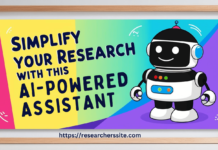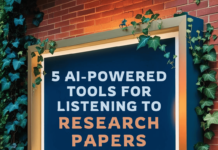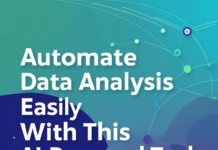In this comprehensive blog post, I will delve into 5 AI tools designed and developed to facilitate interactions with research papers.
Artificial intelligence (AI) is rapidly transforming the way we research and learn. In the field of academic research, AI is being used to develop tools that help researchers find, understand, and cite research papers more effectively.
However, reading and interacting with research papers can be a daunting task, especially for those who are new to the field. Fortunately, there are many AI-backed tools available that make conversing with research papers more accessible and efficient than ever before.
Here begins the first part (Part-I) of three-part blog series about the AI tools for interacting with research papers.
5 AI Tools for Interacting with Research Papers
If you want to make your academic paper more interactive, you have come to the right place. The purpose of this blog post is to provide insights into a collection of 5 AI-powered tools for interacting with research papers.
Here are 5 AI tools for conversing with academic research papers.
No. #1 ChatPDF
ChatPDF is an AI tool that allows you to extract relevant information from your paper. The user-friendly web application lets you convert your research paper into an interactive chatbot in just a few minutes.
Using ChatPDF is as simple as uploading your research paper and customizing your chatbot.You do not need any coding experience or technical skills to do the same.
This tool is available to anyone, regardless of their technical skills. The AI-backed tool can help academic researchers to extract relevant information from PDF academic papers.

This handy tool transforms the text within a paper into a format that is simple to search and analyze. This is a useful tool for researchers who need to quickly find specific information in a research paper.
In an earlier blog, I demonstrated elaborately how to use the ChatPDF to turn your academic paper into an interactive chatbot.
No. #2 Humata AI
Humata AI is an AI-powered tool that helps you research, learn, and create faster. It can summarize research papers, answer your questions about your paper, and generate new writing based on your documents.
You can access the AI-driven tool by entering the URL (https://www.humata.ai) into your browser’s address bar.
Upon accessing the website, the following page will be displayed:
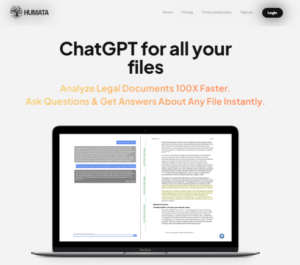
After setting up your account, you can proceed to upload the research paper (PDF format) you want to analyze. Now, you locate the paper on your local machine and easily drag and drop it into the designated section on the Humata platform.

Once you have uploaded the paper, the sophisticated AI algorithms will start analyzing and comprehending the content of your paper. It will take few seconds to process the paper.
Humata is based on OpenAI’s ChatGPT, and it can be used to interact with a variety of files, including PDFs, word documents, and spreadsheets.
Once the processing is finished, you can interact with its chatbot. It is located in the left pane of the interface.
The AI chatbot will promptly furnish you with clear and comprehensible answers in real-time.
Humata AI helps you to answer hard questions related to your research papers. It also summarizes long papers and extracting key points.
You can visit their website here to learn more about Humata AI and its features.
Overall, Humata AI is a powerful tool that leverages AI technology to assist users in various aspects of academic research, data analysis, and document management. It offers features that enhance efficiency, provide valuable insights, and simplify complex information.
No. #3 Perplexity AI
Have you ever wished you could chat with any scholarly content and ask questions about it in natural language? Well, now you can with Perplexity AI, a new AI chat tool that acts as an extremely powerful search engine.
Perplexity AI is an AI-powered tool that lets you answer your questions in a comprehensive and informative way. It uses large language models and search engines to achieve this, allowing it to provide answers to a wide range of questions.
It is capable of understanding natural language inputs, as well as providing answers to more specific questions.
Perplexity AI is a web crawler that uses machine learning to generate general answers to your queries and then offer a series of website links. The links are to websites that the AI thinks are relevant to your query.
Perplexity AI offers a seamless experience by allowing you to ask any question using simple, everyday language. The beauty of this tool lies in its ability to provide you with comprehensive and informative answers.
It shows you the sources it used to answer your questions and encourages follow-up inquiries.
Sharing your questions and answers with others, the tool promotes collaborative learning
You can use either of these two methods to access the AI-driven tool:
- Access the Perplexity website
2. Setup the Perplexity Chrome Extension
Perplexity AI is free to use and available on the web and as an app for iPhone users. To use Perplexity AI, you need to visit their website here or download their app here.
You can enter your question in the box and the AI-assisted tool will provide you with an answer based on the ChatGPT.
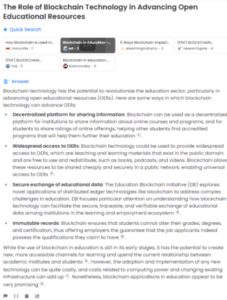
In a previous blog, I demonstrated elaborately on how to use the perplexity AI search engine tool for academic research.
The Perplexity AI is a powerful tool that can help you find relevant information on any topic quickly and accurately.
Besides, you can use the Google Chrome extension to ask contextual questions about the website you are visiting.
No. #4 ChatDOC
Have you ever wished you could chat with any document and ask questions about it in natural language? Well, now you can with ChatDOC, a new AI tool that acts as an AI-powered file-reading assistant.
ChatDOc allows you chat with any paper and get instant answers with cited sources. It is a handy file-reading assistant powered by ChatGPT.
It is great at quickly pulling out, finding, and summarizing information from various document formats—like .pdf, .docx, .md, and even scanned files.
ChatDOC is free to use and available on the web and as an app for Android users.
You can upload or paste any source of information into the tool and start asking questions. ChatDOC will provide you with responses based on the source and the ChatGPT model parameters.
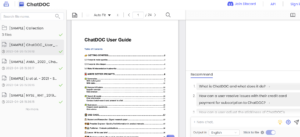
Users can ask questions and get instant answers from ChatDOc, which can save time and effort. ChatDOc provides cited sources for its answers, which can help users verify the accuracy of the information.
With its versatile abilities, ChatDOC becomes an invaluable tool for efficiently analyzing documents and capturing essential insights.
ChatDOc can be a useful tool for anyone who needs to quickly find information in a document. It can be especially helpful for researchers who need to read and analyze large amounts of text.

ChatDOC is a powerful tool that can save time and effort for individuals who frequently read and analyze documents. It provides a convenient way to extract information, locate specific details, and summarize content, ultimately enhancing the reading and learning experience
No. #5 PDF.ai
PDF documents are a ubiquitous format for storing and sharing information. However, they can be difficult to interact with, especially if they are large or complex.
PDF.ai is an AI-powered tool that can help you interact with PDF documents in a variety of ways.
With PDF.ai, you can understand the content of a research paper and answer your questions about it in plain English.
This can be helpful if you need to quickly get the main points of your paper.
The state-of-the-art tool can extract tables and data from your article for analysis. Besides, the tool can summarize the data in a table or spreadsheet.
The online application translates the research paper into different languages. This can be beneficial if you read a PDF document in a language you are unfamiliar with and need to read it.
The tool allows you to convert PDF paper to other formats, such as Word, Excel, and PowerPoint. It is capable of handling OCR-scanned research papers that was scanned from a hard copy.
Upon visiting their website, the first step is to complete the signup process. Following this, a confirmation email will be sent to your provided email address.
Once you confirm your registration through the email link, you can access the tool’s features.
Here is a snapshot depicting the interface for your paper uploading:

Upon uploading your paper, you can begin interacting with the paper. In my case, I used a paper on Bitcoin sourced from their website.
The window below will be visible to you:
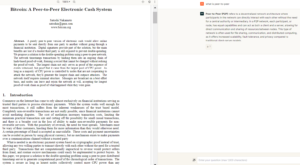
It is a powerful tool helps you save time and improve your productivity when working with your research documents.
If you need an affordable and powerful AI-powered tool for interacting with your academic paper, consider using PDF.ai.
You can add the PDF.ai extension to your Google Chrome browser to start interacting effortlessly with any academic papers.
Conclusion
AI tools are essential for enhancing your research skills and knowledge. These tools help you interact with research papers using natural language queries. The AI-powered tools can provide you with summaries, answers, and insights as you read the scholarly content.
You can also use these tools for various tasks such as literature review, citation analysis, text generation, and text synthesis. They have different features, accuracy rates, and prices, but they all provide reliable and useful services for interacting with research papers.
I hope you enjoyed this blog post and found it helpful for your research needs. If you liked this post, please share it with your friends and colleagues who might also benefit from it. Stay tuned for more posts on AI tools and research in the future.



